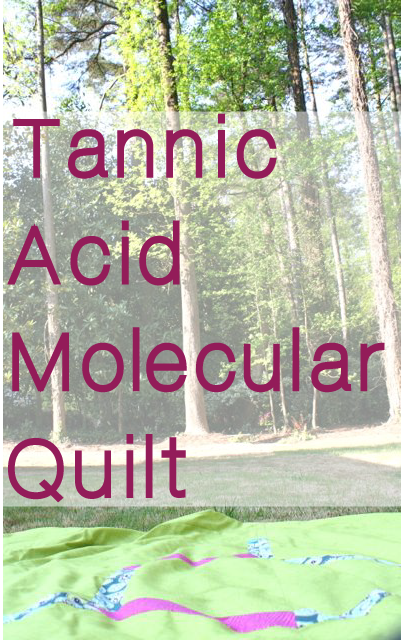
Once upon a time, before Whipstitch existed, I was an archaeologist. My field of study was prehistoric human/plant interactions, focusing on acorn use as a primary foodstuff in the American Southeast. (This is a true story, y’all. Some folks really do study this kind of thing.)
You can imagine what spending two years grinding acorns that you collected by hand in a mortar and pestle and weighing the resulting acorn meal to compare with other batches does to a person. I pretty much had two choices: despise acorns and shudder at the sight of them, or become hopelessly enamored of the little guys and everything they represent.
I chose the latter. I, my friends, am an Acorn Lover.
I have acorn quilts and acorn decor and acorn earrings. I have a squirrel-and-acorn skirt and acorn serving platters. I looooove me some acorns.
So when Ali contacted me about her new book, Quilt Lab, and I saw that there was a quilt of a molecule, only one molecule sprang to mind for me: tannic acid.
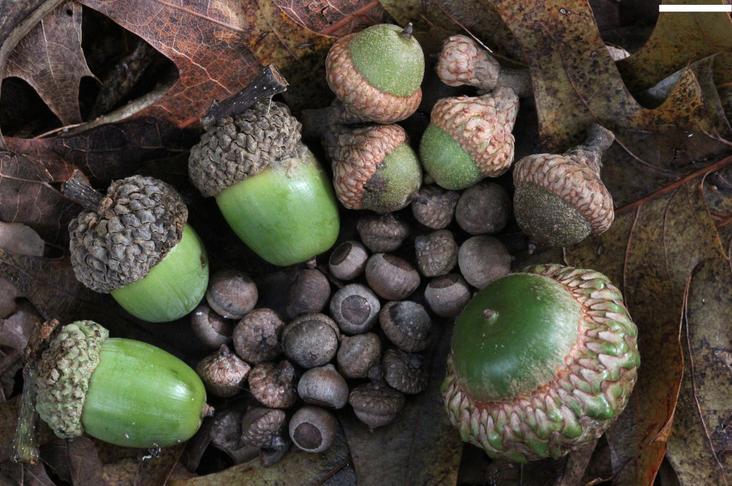
Tannic acid is the primary chemical constituent in acorns, the part that preserves them underground over the winter and allows them to sprout again when spring comes around. Tannic acid is so prevalent in some species of acorn that they were the original source of tanning solution for the leather industry (get it? TANNIC acid?). Acorns have been consumed as a food by every civilization on every continent on Earth, throughout history. Plus, they’re cute as a little button, which is a bonus.
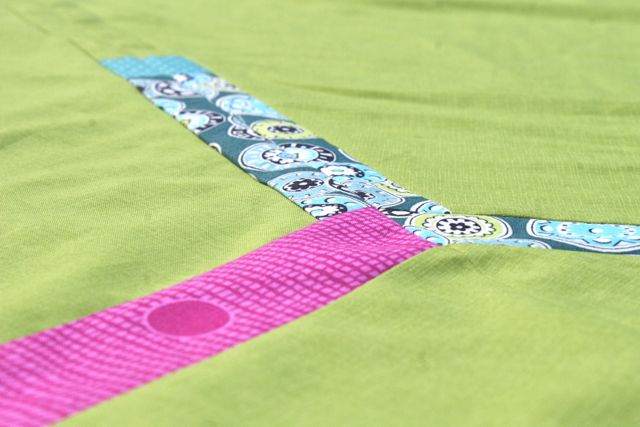
Ali’s Molecular Quilt, from Quilt Lab, takes the love of chemistry to geeky, quilty heights–I totally am feeling it. She worked with both a large hexagon and a large pentagon to piece together the molecular structure of caffeine. Since I am not a caffeine drinker, I wanted to branch out and try a molecule closer to my own heart (although I recognize that for most folks, caffeine would be exactly the molecular quilt they’d be most likely to appreciate!).
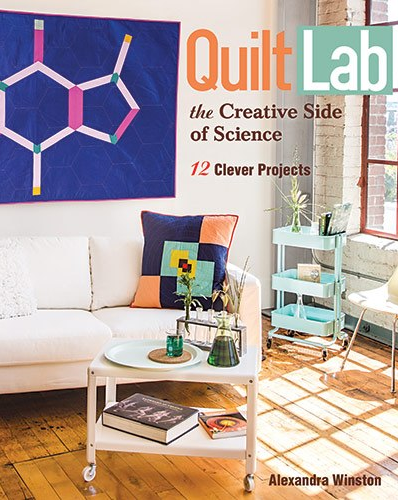
The whole book is like that. Ali has taken ideas and motifs and quilt structures that are familiar to us and used her background in math and science to present those quilt ideas in a really new and cool way. I loved the concept of this book from before I even saw the projects–and once I saw the projects, I knew I had to sew some of them up.
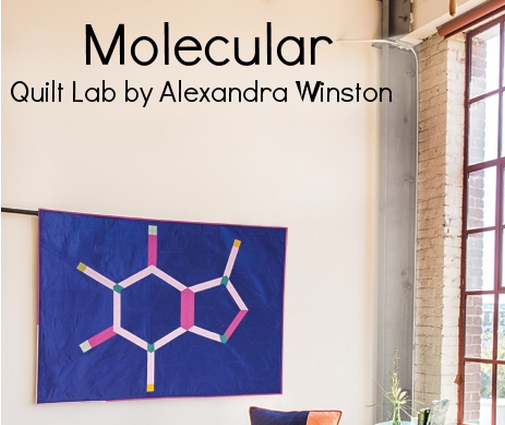
Her version of molecular is on a dark blue background with pops of pink, but what I love most about it is that it’s also chemically accurate: her instructions walk you through using different colors of fabric to represent single bonds, double bonds, and individual elements across the molecule. I wasn’t making the same chemical structure, but her instructions were so careful and well-written that I was able to use her fundamental ideas to translate the design into a different molecular structure:
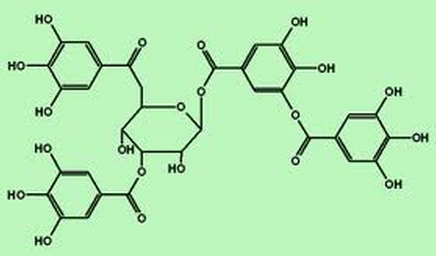
This is tannic acid. Now, this is obviously a larger molecule than caffeine. I had originally intended to create the entire molecule, but my starting pieces–the triangles at the heart of each hexagonal group–were so big that the finished quilt would have been a double-king sized quilt, which is too big even for me. Go big or go home, and all, but I want to actually USE this quilt. So I stuck with creating just one functional group, the hydroxy group that appears four times in this molecule, as a simplified representation of tannic acid.
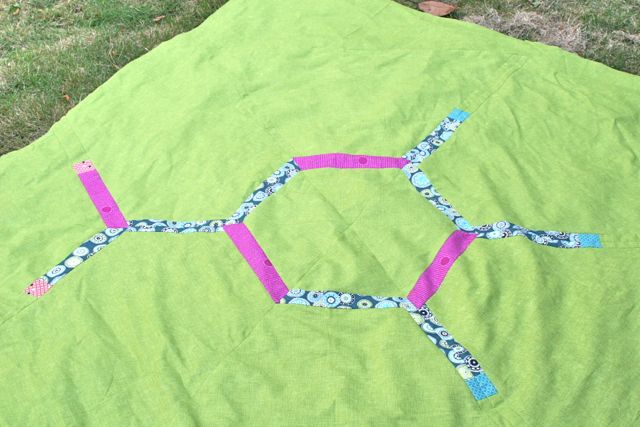
The body of the molecule is all Denyse Schmidt prints. I used a bright pink for double bonds, a blue medallion print for single bonds, and an aqua and an orange for the OH and O groups. The background is Quilter’s Linen from Robert Kaufman, in my signature chartreuse.
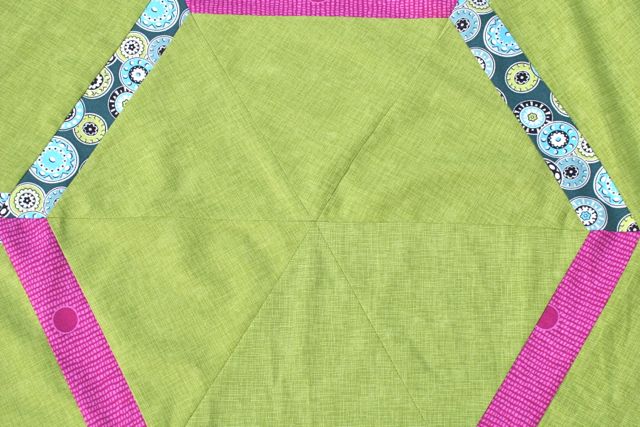
Each of the segments of the hexagon at the heart of the molecule are pieced as triangles, and then brought together. I think it’s crazy clever the way Ali has worked that out in this design, and how she even took the time to plan out the “spokes” coming off the hexagon, pieceing them at half the width so they’d appear to be shared across the angle of the hex:
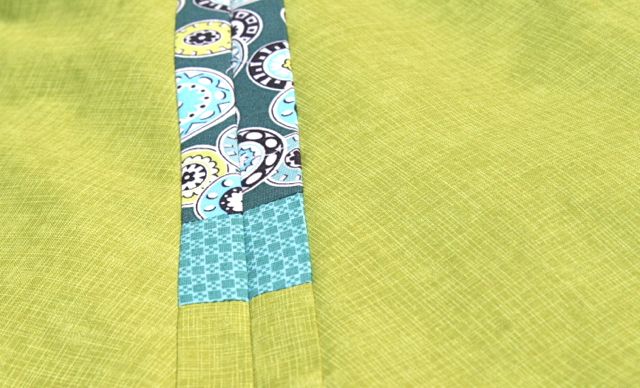
The measuring was simple and consistent, and the results were so worth it. Plus, because this wasn’t just a shape but reflected something concrete from nature, the patchwork was immensely satisfying.
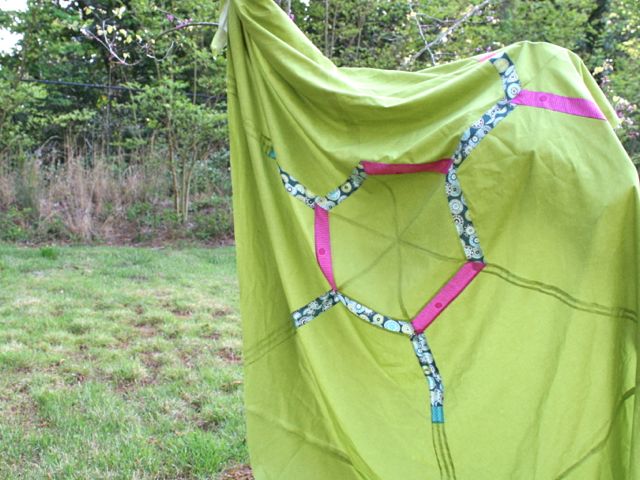
Here you can get a better idea of where all those seams lie. For the vast majority of the quilt top, I pressed my seam allowances open, particularly at the seams where the triangles meet. I find that the center point of that hexagon lie much, much flatter when those seams are pressed open–another tip in Ali’s directions for this quilt.
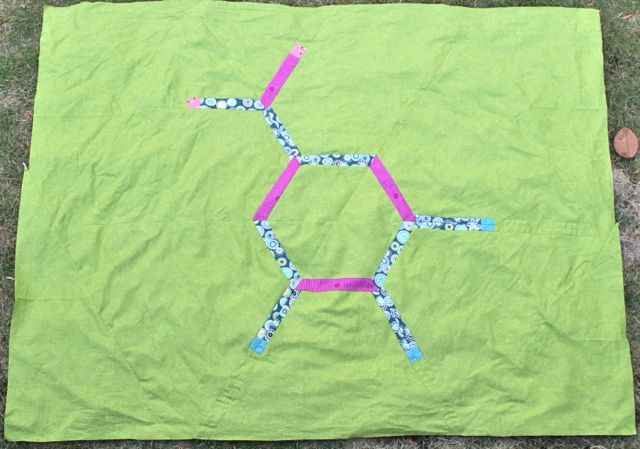
I’m still just the tiniest bit sad that this isn’t the entire molecule, but since this quilt top clocks in at around 50″ x 65″ I am totally letting myself off the hook. It might be fun to make a mini with the entire structure on it, though!
I’ll be quilting this with narrow straight line stitches across the width of the quilt–can’t wait to share the finished result with you!
In the meantime, check out the other stops on Ali’s Quilt Lab blog tour–I think you’ll be really impressed not just with the quilt designs themselves, but the way Ali has really showed her teacher’s heart in the structuring of the book, the design of each project to build on the ones previous, and the categories she has used to reveal how the natural world can influence and guide our patchwork. I genuinely think it’s a dreamy quilting book, and one to add to your collection!
ADDITIONAL BLOG TOUR STOPS:
March 11 – Head over to Andrea’s blog (Knitty Bitties) for her take on Fractal
March 18 – Bonnie (Pink Stitches) is mixing up Scattered
March 24-31 – Link Party on Ali’s blog
April 8 – Megan at Canoe Ridge Creations will be modifying on States of Matter
April 15 – Amy Lou Who knows her Calculus (does anyone remember 2Gether?)
April 22 – Deborah from Whipstitch has an awesome new molecule to show you for Molecular
May 6 – Katy from I’m a Ginger Monkey gives us some Culture(d)May 13 – Lindsay (lindsay lindsay) from Lindsay Sews has an Echo
May 20 – Amanda from A Crafty Fox (and Westwood Acres) will make you shudder with a cool version of Aperture Science
May 27 – Angela Cut To Pieces and I teamed up for a joint free pattern!!



Bookbabe49
April 22, 2014 at 3:06 pmAll your photos show up then mysteriously disappear.
Whaaaaaaat?
Deborah
April 22, 2014 at 5:22 pmWhoa–totally weird! On your desktop or tablet?? Will see if I can find any reason why it’s doing that to you–looks fine over here, but I can always tinker! 🙁
Melissa Irvin
April 23, 2014 at 10:28 amHi Deborah, in light of your love of acorns, I would like to send you something. Where might I send it? 🙂
Deborah
April 23, 2014 at 11:10 amOh, aren’t you the sweetest thing?!? IS IT A PONY?? 🙂
I’ll email you my details. And thanks!
Sabrina B.
April 24, 2014 at 6:55 amLove this! As a biologist, not sure which molecule I’d choose. Estrogen, perhaps?
Deborah
April 24, 2014 at 9:27 amHaha!! I would *so* hang a mini-quilt w the estrogen molecule on my wall. And point to it with a knowing nod when my hormones go wackadoodle (which hardly ever happens, am I right?).
🙂